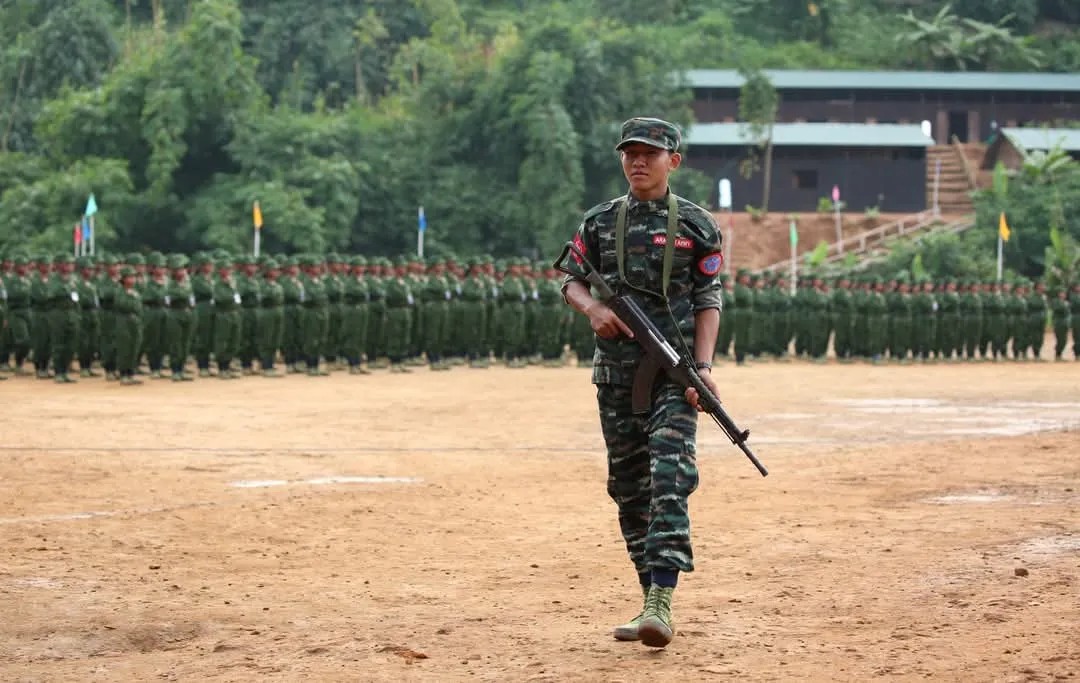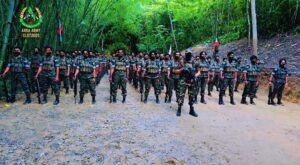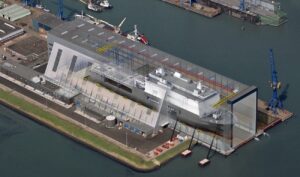Rising kidnappings, cross‑border threats, and criminal networks linked to the Arakan Army have made Bangladesh’s south-eastern frontier a flashpoint. Dhaka must act now — first with intelligence‑led, non‑lethal deterrence, and second with a clear military escalation doctrine should things go south.
Containing the Arakan Army without Crossing the Line
The Naf River is no longer just a line on the map. For Bangladesh, it has become the frontline of a growing security crisis. Over the past year, the Arakan Army — a Myanmar‑based armed group — has moved from being a distant insurgency to a direct threat to Bangladesh’s sovereignty and safety. More than 350 Bangladeshi citizens have been abducted, fishing trawlers seized, and the BGB publicly challenged. At the same time, there are credible reports of the AA supplying arms and shelter to anti‑Bangladesh insurgents in the Chittagong Hill Tracts and trafficking narcotics in exchange for essential goods from Bangladesh.
These are not isolated acts of violence. They represent a strategy to extend influence and weaken the state’s capacity to defend its frontier. For Bangladesh, the stakes are threefold: protecting citizens, securing sovereignty, and denying the AA’s criminal economy the lifeline it needs to sustain violence. Failing to act decisively now carries consequences. More abductions will erode public trust. Sanctuaries will become entrenched, making later operations costlier and riskier. Expanded drug trafficking will fuel corruption and crime. And a worsening crisis in Rakhine will almost certainly trigger another refugee influx — a challenge that would strain resources and stability.
The correct first line of defence is not force alone, but intelligence‑driven deterrence. Bangladesh must invest in persistent surveillance, integrated interdiction, law enforcement cooperation, economic denial, and humanitarian readiness. These tools give Bangladesh the ability to deter without crossing the threshold into dangerous escalation.
Surveillance first is key. Unarmed long‑endurance UAVs must be deployed for persistent ISR over the Naf, Cox’s Bazar approaches, and key riverine routes. These drones can track smuggling routes, monitor staging areas, and detect hostile movement patterns in real time. But their deployment must rest on a foundation of law — with clear authorisations, parliamentary oversight, and transparency to ensure legitimacy.
Surveillance is only valuable if it leads to action. Intelligence must flow seamlessly into coordinated interdiction. The BGB, Coast Guard, and Police must operate as a single integrated force, sharing intelligence and executing rapid, evidence‑backed operations. This is how abductors and smugglers can be denied sanctuary, and how justice can be delivered rather than deferred.
Criminal finance is the AA’s fuel. Methamphetamine and heroin trafficking are central to its operations. Bangladesh must intensify counter‑narcotics operations, expand maritime interdiction, seize illicit assets, and work with UNODC and regional partners to dismantle trafficking networks. This is not an act of war, but of strategic denial.
Preparedness must also account for the humanitarian dimension. Violence in Rakhine will inevitably produce displacement. Bangladesh must act in advance — pre‑positioning shelter, medical capacity, and screening systems in Cox’s Bazar and Teknaf, while coordinating with UN agencies to ensure orderly reception. Screening must separate genuine refugees from infiltrators to protect both humanitarian integrity and national security.
Finally, resilience comes from the ground up. Bangladesh must strengthen local coastal and hill communities so they become active participants in their own defence. This requires investment in livelihoods, community policing, and civic engagement to undercut the appeal of smugglers and recruiters.
Non‑lethal measures are the first choice — intelligence, interdiction, economic denial, and humanitarian readiness. They protect sovereignty without creating a wider battlefield.
Preparing for the Worst
Even the most thorough non‑lethal strategy cannot guarantee success. If the Arakan Army grows bolder, if kidnappings persist, if sanctuary is granted to hostile actors, Bangladesh must be prepared to escalate in a measured, lawful way. Escalation must be deliberate and proportionate, designed to defend sovereignty while avoiding uncontrolled conflict.
The first element of credible deterrence is visibility. Bangladesh must demonstrate capability and intent. This begins with posture: increasing patrol density along the Naf and Cox’s Bazar approaches, maintaining routine ISR sorties, and forward‑deploying rapid reaction units. Visible readiness alone can deter aggression.
Maritime and riverine control will be central to any escalation plan. Bangladesh must treat the Naf and its territorial waters as a controlled barrier. That means expanded patrols, tighter interdiction, integrated sensor coverage, and denying hostile actors the freedom to operate at sea. Control over maritime approaches transforms the river into a defensive line, not an open gateway.
Hardened forward positions matter. Vulnerable posts along the border and in the CHT must be reinforced with modern equipment and mobile rapid‑reaction forces. Preparedness buys decision makers time, reduces risks, and limits the need for premature kinetic action.
If force becomes unavoidable, it must be controlled. Defensive strikes should be narrowly tailored, legally justified, and transparently communicated. Bangladesh must avoid punitive campaigns that could spiral into wider war. Kinetic action should always be a last resort, with clearly defined targets and legal oversight.
Non‑kinetic measures also have a critical role in escalation. Electronic warfare, financial sanctions, and targeted psychological operations can degrade enemy capacity without the cost of open conflict. These tools are force multipliers, giving Bangladesh leverage without crossing thresholds of war.
Integration is essential. Army, navy, coast guard, paramilitary forces, and police must work under a unified command with clear escalation protocols. Unity of effort ensures speed, coherence, and accountability.
Bangladesh must also internationalise deterrence. The Arakan Army threat cannot be treated solely as a domestic matter. Dhaka should work through ASEAN, the United Nations, and bilateral channels to press Myanmar and partners for action. Humanitarian access to Rakhine, targeted sanctions, and joint interdiction will amplify deterrence and isolate hostile actors.
A published or internal “ladder of escalation” will define thresholds for action and send clear signals to adversaries and allies alike. This clarity strengthens deterrence and minimises the risk of miscalculation.
Bangladesh stands at a strategic crossroad. The Arakan Army is a complex threat — military, criminal, and humanitarian. The answer is not impulsive retaliation, but a disciplined doctrine combining intelligence dominance, targeted interdiction, humanitarian readiness, and proportionate defence. That is how Bangladesh protects its sovereignty without becoming drawn into a wider war.
Firmness with foresight
The threat at the edge of the Naf is not just a test of Bangladesh’s military capability, but of its strategic maturity. Bangladesh must act now with a two‑tiered approach: first, through intelligence‑driven non‑lethal measures to contain and deter; second, through a clear, lawful deterrence doctrine prepared for escalation if needed. Strength without restraint risks chaos. Restraint without strength invites aggression. Bangladesh’s goal must be to sharpen its edge without losing control.
“A clear ‘ladder of escalation’ is essential. Bangladesh must make it known that aggression against its citizens will meet a proportionate and lawful response, backed by a unified command and credible capabilities.”
Operational Checklist — Bangladesh’s Response to the Arakan Army Threat
Non‑Lethal Preparedness
- Establish persistent UAV surveillance over Naf River and Cox’s Bazar approaches.
- Integrate BGB, Coast Guard, Navy, and Police ISR into a joint operations centre.
- Expand interdiction capability — maritime, riverine, and coastal.
- Strengthen anti‑narcotics operations and cross‑border intelligence sharing.
- Pre‑position humanitarian response capacity at Cox’s Bazar and Teknaf.
- Develop community resilience programmes in coastal and hill areas.
Escalation Planning
- Maintain visible forward presence with patrols and ISR sorties.
- Harden vulnerable posts along the Naf and CHT frontier.
- Develop rapid‑reaction forces with clear rules of engagement.
- Integrate Army, Navy, Coast Guard, and law enforcement under a joint command.
- Maintain legal oversight for all kinetic operations.
- Establish a published or internal “ladder of escalation” doctrine.
Deterrence and Diplomacy
- Engage ASEAN, UN, and bilateral partners on Rakhine access and interdiction.
- Apply targeted sanctions and travel restrictions against facilitators.
- Coordinate with UNODC and regional agencies to dismantle trafficking networks.
- Use diplomatic signalling to communicate thresholds for escalation.
- Maintain public transparency and accountability in operations.

Khaled Ahmed is a seasoned former intelligence analyst and military expert from the Netherlands, bringing over 15 years of specialised experience in operational intelligence, threat analysis, and strategic defence planning. Having served in high-level, classified roles within Dutch military intelligence, he possesses rare expertise in European security architecture, NATO doctrine, and asymmetric warfare. Khaled’s deep operational insight and international perspective enable him to deliver precision-driven intelligence analysis and forward-looking strategic forecasts. A trusted contributor to high-level risk assessments and security briefings, he offers readers clarity on complex defence and security challenges. Khaled leads the National Security and Fact Analysis sections at BDMilitary. He holds a Master’s degree in International Relations from the University of Groningen, The Netherlands, and is fluent in Dutch, French, and Arabic — combining linguistic dexterity with operational expertise to analyse security issues across cultures and regions.



